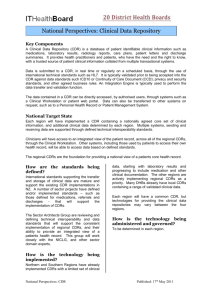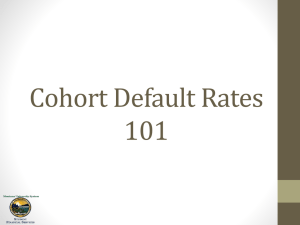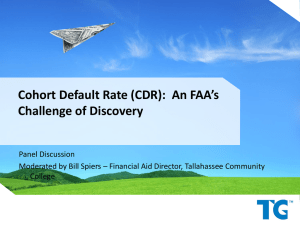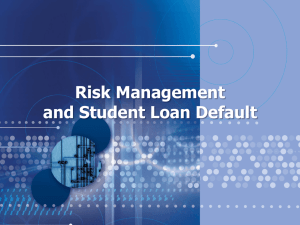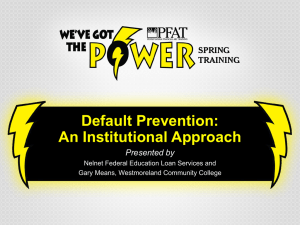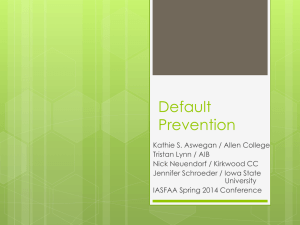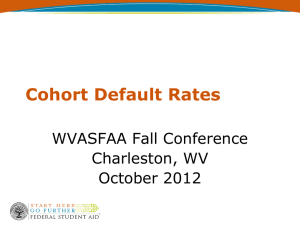Delinquency management and prevention - DE-DC-MD
advertisement
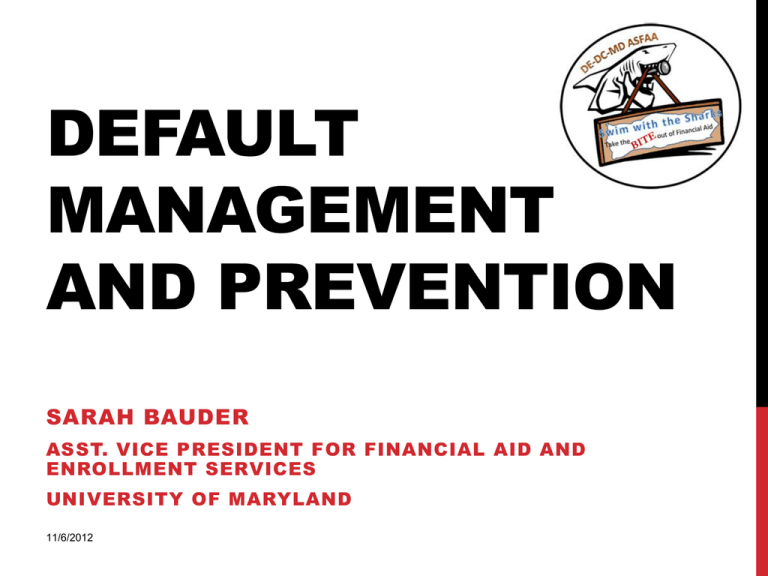
DEFAULT MANAGEMENT AND PREVENTION SARAH BAUDER ASST. VICE PRESIDENT FOR FINANCIAL AID AND ENROLLMENT SERVICES UNIVERSITY OF MARYLAND 11/6/2012 11/6/2012 STUDENT LOANS IN THE MEDIA 11/6/2012 AGENDA • Cohort Default Rate Overview • Does Default Prevention Help? • The Consequences • The Changes, Risks and Challenges • Default Prevention Strategies • Financial Literacy • Case Study 11/6/2012 A COHORT DEFAULT RATE OVERVIEW 11/6/2012 CDRs ARE RELEASED TWICE A YEAR 11/6/2012 February (DRAFT) September (Official) • Not public • Public • No sanctions • Sanctions apply • No benefits • Benefits apply CDRs: THE FORMULA Numerator: Denominator: 11/6/2012 Borrowers who entered repayment in one year, and defaulted in that year or the next Borrowers who entered repayment during the one-year cohort period CDRs: DENOMINATOR IN FORMULA • Determine Data Entered Repayment (DER) • Date of graduation, withdrawal, or less than half-time status • Plus 181 days (6 months + 1 day) = DER • Using DER, determine the correct cohort year in which the student will be counted 11/6/2012 CDRs: NUMERATOR IN FORMULA • Loan must be included in denominator • Determine default date (361 day of delinquency or Claim Paid Date [CPD]) • Determine if default date falls within cohort period 11/6/2012 CDRs: TWO FORMULA’S: APPLYING THE FORMULA • Non-Average Rate • 30 or more borrowers in repayment • Average Rate • Less than 30 borrowers in repayment • 3 years of data 11/6/2012 USING THE NON-AVERAGE RATE FORMULA Calculation: For a school with 30 or more borrowers entering repayment in a fiscal year (N) 5 x (D) 11/6/2012 225 100 = 2.2% USING THE AVERAGE RATE FORMULA Calculation: For a school with less than 30 borrowers entering repayment in a fiscal year (N) 5 3 + 1+ 1 x = (D) 20 + 17 + 10 100 = 10.6% 47 FY06 FY07 FY08 The sum of the three most recent cohort periods 11/6/2012 2 TO 3 YEAR CDR (A SCENARIO) Numerator = # of borrowers from the denominator who default within a FY Denominator = # of borrowers who enter repayment within a FY Year 1 Year 2 125 125 5,000 Year 1 Year 2 Year 2 125 125 125 5,000 355 5,000 = .071 7.1% Released Sept 2011 605 5,000 = .121 12.1% Released Sept 2011 11/6/2012 THE 3-YEAR CDR CALCULATION • Expands the default tracking window from 2 years to 3 years • Creates a transition period (FY09/10/11) • Raises penalty threshold from 25% - 30% • New set of requirements for FY09, FY10… • Possible compliance issue beginning in September 2014 (FY 2011 CDR) • Increases availability of “disbursement relief” from 10 to 15% (effective 10/1/11) 11/6/2012 CDR DISBURSEMENT WAIVERS FOR LOW DEFAULT RATES • New threshold: Schools with a default rate less than 15% for the 3 most recent fiscal years • May disburse a single term loan in a single installment, and • Need not delay the first disbursement to a firstyear undergraduate borrower until the borrower has completed the first 30 days of their program of study Effective for loans first disbursed on or after October 1, 2011 11/6/2012 3-YEAR CDR CORRECTIVE ACTIONS • First year at 30% or more • Default prevention plan and task force • Submit plan to FSA for review • Second consecutive year at 30% or more • Review/revise default prevention plan • Submit revised plan to FSA • FSA may require additional steps to promote student loan repayment • Third consecutive year at 30% or more • Loss of eligibility: Pell, ACG/SMART, FFEL/DL • School has appeal rights 11/6/2012 INSTITUTIONAL CDR CALCULATIONS BY CDR YEAR Table 2. Publications of 3-year CDR CDR Denominator: Enter Repayment Numerator: Default Publish 2-Year Rates FY 2009 10/1/08 - 9/30/09 10/1/08 - 9/30/11 September 2012 N/A FY 2010 10/1/09 - 9/30/10 10/1/09 - 9/30/12 September 2013 N/A FY 2011 10/1/10 - 9/30/11 10/1/10 - 9/30/13 September 2014 3-year rate FY 2012 10/1/11 - 9/30/12 10/1/11 – 9/30/14 September 2015 3-year rate FY 2013 10/1/12 – 9/30/13 10/1/11 – 9/30/15 September 2016 3-year rate FY 2-14 10/1/13 – 9/30/14 10/1/12 – 9/30/16 September 2017 3-year rate 11/6/2012 Rate Used for Sanctions NATIONAL STUDENT LOAN DEFAULT RATES DOES DEFAULT PREVENTION HELP? The changes, risks and challenges 11/6/2012 THE CONSEQUENCES OF DEFAULT FOR THE SCHOOL • The CDR is a measure of a school’s administrative capability • High CDRs can: • Negatively reflect on school quality • Result in provisional certification • Result in loss of Title IV eligibility 11/6/2012 THE CHANGING LANDSCAPE • Loan default increasing for most schools • Educational costs continue to rise • More students borrowing more money • The combination of Stafford and private loans equal greater debt • Changes to CDR calculation accompanied by new sanctions and enhanced benefit • Transition to all Direct loan Origination and Servicing 11/6/2012 DEFAULT PREVENTION STRATEGIES 11/6/2012 FINANCIAL LITERACY • http://www.financialaid.umd.edu/literacy/ 11/6/2012 WHAT WE DO TO KEEP OUR RATES LOW Be Proactive: Know Who Could Default Financial Literacy Classes for New Students Satisfactory Academic Progress Cash Course Requirement 8% rule – Profile Students One-on-One Counseling Encourage Limited Borrowing 11/6/2012 GOOD RESOURCES • Default management sample plan from FSA http://ifap.ed.gov/dpcletters/GEN0514.html • Cohort Default Rate: The Cohort Default Rate Guide http://ifap.ed.gov/drmaterials/finalcdrg.html • Default Prevention Resources http://ifap.ed.gov/DefaultPreventionResourceInfo/ • Operations Performance Management Service Group (CDR Calculations and data challenges) • • • • 11/6/2012 Main line: 2020-377-4258 Hotline: 202-377-4259 Email: fsa.schools.default.management@ed.gov Web: http://ifap.ed.gov/DefaultManagement/DefaultManagement.ht ml CASE STUDY - UMD Default Rate Graduated Didn’t Graduate Total Any Academic Probation 8% 19% 14% (20) Undergraduate Studies Major 6% 22% 12% (21) High School GPA > 1.4 < 2.3 9% 19% 12% (15) Last Cum UG GPA >1.4 < 2.3 7% 13% 10% (178) Black/Af. American 7% 17% 9% (207) 30+ Years Old 6% 12% 8% (36) Any Alternative Loan 3% 18% 7% (49) Unmet Need > $7,000 < $10,500 5% 14% 7% (85) Average EFC <=$2,500 5% 14% 7% (225) Independent 5% 12% 7% (129) Enrolled 13+ Terms 4% 20% 6% (112) Cumulative Loan Amount > $20,000 4% 20% 6% (81) Total 3% 10% 4% (404) 11/6/2012 QUESTIONS? Contact: Sarah Bauder sbauder@umd.edu 301-314-8279 11/6/2012
